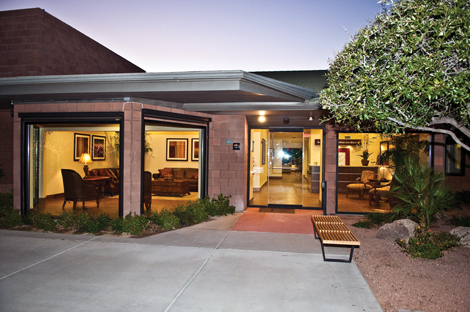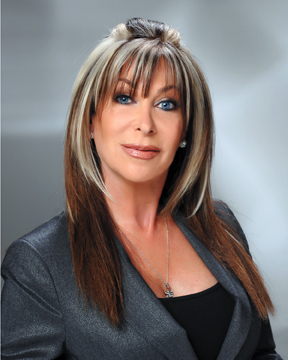Serenity Hospice and Palliative Care of Phoenix has tended to more than 7,000 local patients. We talked with Serenity's president and founder, Ruth Siegel, about this very special line of work.

Ruth siegel, president and founder of Phoenix’s Serenity Hospice and Palliative Care, nurse-owned and-operated since 2005, began as a labor and delivery nurse before accepting a position in hospice care 16 years ago. “I just fell upon it,” she says. “I started in Hospice [Family] because a friend, then the chief medical officer at Arrowhead Hospital in Glendale, told me about an opening.” Within one year of working in both admitting patients and marketing, Siegel founded VistaCare Hospice in Phoenix, which later became one of the largest nationally recognized hospices. Prior to the company going public, Siegel went on to work for Hospice of the Valley where she increased the number of patients from 500 to 1,900 in less than two years. “With hospice, you get to spend more time with the patient; it’s a critical time, it’s end-of-life care,” Siegel says. “I think it takes a special kind of nurse to do this.” Although Siegel is no longer a practicing nurse since opening Serenity Hospice and Palliative Care, she utilizes her education and knowledge to determine what the best care is for each patient. Today, Serenity Hospice and Palliative Care has tended to more than 7,000 patients from around the state. AFM sat down with Siegel to talk about hospice care and how Serenity can help life-limiting patients and their families.

Serenity's President and Founder Ruth Siegel
What is hospice care?
Hospice care is a philosophy. It is for someone who has a life-limiting illness and a prognosis of six months or less to live, without medical intervention. But people are receiving intervention like oxygen or medication, so they are living longer. We don’t have a crystal ball that can predict how long a patient will survive. If they are on hospice service longer than six months and still meet hospice criteria, they can continue utilizing our service. They are initially re-revaluated after 90 days and then every 60 days after that.
What are some life-limiting illnesses that qualify patients for hospice care?
Everyone thinks of cancer, but there’s also cardiac disease, chronic lung disease, Alzheimer’s disease, Parkinson’s disease, and what we [at Serenity Hospice] call too-many birthdays or TMB—no specific illness other than one’s health suddenly declining.
Is hospice care only available at homes?
No. If the patient needs a higher level of care (their symptoms and/or pain are out of control or the family can’t handle them dying at home), they have the option to go to our beautiful in-patient facility. We are one of four hospices that have licensed facilities. The 60-plus [other Valley hospices] utilize a nursing home for patients with these needs.
For home hospice care, how many individuals make up a medical team?
The team is made up of a nurse, a CNA (nurse’s aide), a physician, a social worker, a bereavement worker and a chaplain. They are all part of an Interdisciplinary Team (IDT) which meets every week to go over patient care.
Is there a different screening process for nurses applying for work in hospice care versus hospital care?
No. I have nurses who work in hospitals who also work on the side in my in-patient unit. It’s like any specialty: Do they want to be involved with end-of-life care?
What types of services can hospice care provide at home?
I would recommend families call several hospices and find out what services they provide. Every hospice has to provide the medical team mentioned above, but they can provide as much or as little [service] as they want. Serenity Hospice nurses visit each patient at least two times a week, and their nurse’s aide [visits] three to five times a week. If patients need someone on the weekends, my nurses and their aides are there. It’s all about meeting the patient at the point of their needs.
Does your not-for-profit facility provide different care then a for-profit?
Profit status makes no difference. In fact, when there is a piece of equipment needed, I make that decision versus getting permission from a board [of directors]. We take patients with no insurance and also have a not-for-profit segment which pays for utilities, clothing, bills and many other special needs a patient or family might have.
How would you describe your hospice facility located in Phoenix?
I would describe our facility as a beautiful, warm, welcoming resort-like environment. It’s a stunning 60,000-sq.-ft. state-of-the-art facility with 20 private rooms, a family room, a dining room and a reflection room. There are two casitas on the property for families from out of town or who want to be on the premises with convenient access to their loved one.
How do you prepare patients for end-of-life care?
From the start of admission. Sometimes we get patients very late [in their illness], and it is more difficult to come in late. Early referrals are better to build a relationship with the patient and their family and to get pain and/or symptoms managed before they become out of control.
What advice do you give for families dealing with the overwhelming emotions of end-of-life care?
I tell them not to look at the word ‘hospice,’ but at the exceptional care they’re going to be getting.
Does Serenity Hospice aid families emotionally after their loved ones have passed?
Yes. Families can get a bereavement of up to 12 months or longer, if needed.
Can you clarify some of the stigmas many face when they hear the word “hospice”?
Fear. But, what people do not understand is that patients live longer on hospice care. It is statistically proven.
Serenity Hospice and Palliative Care
602.216.2273, www.serenityhospiceaz.com
